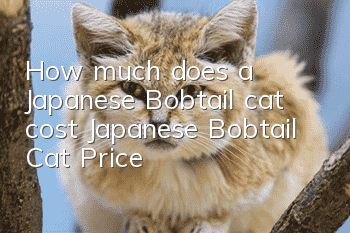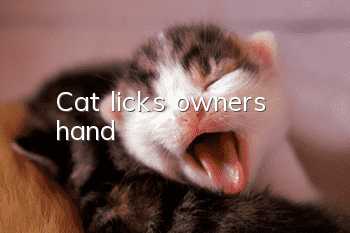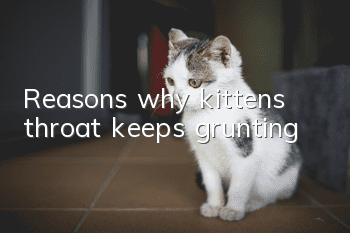How much does a Japanese Bobtail cat cost? Japanese Bobtail Cat Price!

The Japanese Bobtail Cat has unique Oriental facial features, a strong body shape and very well-developed muscles. The body hair is very smooth, and all coat colors are recognized, but the white, black, and brown mixed calico cats are the most popular. He has a cheerful personality, attaches great importance to affection, and takes great care of the kittens. So how much does a Japanese Bobtail cat cost? Next, let’s follow the editor to find out.
How much does a Japanese Bobtail cat cost?
The Japanese bobtail cat, also known as the Lucky Cat, is very popular in Japan. As soon as cat lovers hear that it brings fortune, they will definitely want to take one home. The purchase price of Japanese short-tailed cats is around 8,000-10,000. Those priced above 10,000 have white as their basic color, three-color ones are more expensive, and there are also dark ones with stripes and other colors similar to tiger belts.
The Japanese Bobtail Cat is one of the oldest cats existing in Japan. It has a lively and naughty personality, and its appearance is also very gorgeous, like exquisite Japanese porcelain. Rich folklore has also been derived from the long history. The most familiar "lucky cat" is one of them. Cats with special red, black and white patterns when they are born are called Mi- Ke (pronounced "Mi K", meaning "three kinds of hair" in Japanese), this cat is considered a symbol of luck. In addition, Japanese bobtail cats are also very popular among many internationally renowned artists. For example, the image of Japanese bobtail cats can often be seen in the works of Ukiyo-e masters such as Utagawa Toyokuni and Utagawa Hiroshige, and they are a symbol of luck.
Characteristics:
Japanese bobtail cats are active, sweet, loving and very intelligent breeds. They love to be around humans, can remember their own names, and respond promptly when someone calls them. They are very people-oriented and want to be the center of family life. They will watch TV and read books with you, and when the doorbell rings, they will also go with you to greet guests. Japanese bobtail cats are also very adaptable and can be content with the noisy family environment and even the "traveling" RV life.
Maintenance matters:
Since the undercoat of Japanese shorthair cats is relatively sparse, both short-haired and long-haired cats are very easy to comb. As long as they are combed regularly every week to remove dead hair, there will be almost no hair tangles, and Because the coat of Japanese bobtail cats is relatively waterproof, the frequency of bathing does not need to be too high. When bathing, special attention should be paid to their tails. You can soak them with warm water first, and you must be gentle during the cleaning process. In addition, the frequency of Japanese bobtail cat nails trimming is once every two weeks.
Japanese bobtail cats need to brush their teeth frequently to prevent the occurrence of periodontal disease, preferably once a day. If this is not possible, oral care should be performed at least twice a week. When cleaning the eyes, you can use cotton balls or soft wet cloths to wipe their eyes. When wiping, pay attention to using different cotton balls or wet cloths for different areas of the two eyes to avoid cross infection.
Owners need to pay more attention to the ears of Japanese bobtail cats. If they need to be cleaned, they can wipe them with a cotton swab dipped in 1:1 diluted apple cider vinegar. Pay attention during the wiping process to avoid damaging the inside of the cat’s ears.
Japanese Bobtail Cats first appeared in North America in 1968. Elizabeth Freret imported three Japanese Bobtail Cats from Japan to the United States. Almost at the same time, another breeder who often traveled to Japan Lynn Beck also began to introduce Japanese Bobtail cats and established the first cattery in the United States focusing on Japanese Bobtail cats. Subsequently, Baker and the like-minded Freire started a breeding program for Japanese bobtail cats in North America. They hoped to restore the appearance of Japanese bobtail cats depicted in Japanese art works in the 16th and 17th centuries. In the process, they also worked together to write the first breed standard for the Japanese bobtail cat.
The long-haired variant of the Japanese bobcat has appeared in art in the Hokkaido area for many years. Because of their longer coat, they have a larger, fluffier tail, but like the short-haired Japanese Bobtail, the long-haired variant has a single coat, so their coat doesn't look as dense. In February 1991, they were accepted by the CFA and allowed to participate in competitions with AOV (other breeds) qualifications. In 1993, the CFA officially recognized the long-haired variant of the Japanese Bobtail cat. Since then, long-haired Japanese bobtail cats have been accepted and loved by more and more breeders, referees and pet-raising families.
Through the continuous efforts of breeders, Japanese Bobtail cats are now able to quickly adapt to changes in the environment. Their exquisite appearance and lovable personality can meet the needs of owners of all ages for pets. From an ancient natural breed, after a series of mutations and natural selection of "survival of the fittest" in a difficult environment, the Japanese Bobtail Cat evolved into a breed appreciated and loved by cat lovers.
- Why do orange cats get fat easily?
- Are cat flea collars useful? Introduction to the functions of cat flea collars
- How old is a cat when it becomes an adult?
- Why does a cat run away when it sees its owner?
- How many days does a female cat usually go into estrus? What are the symptoms?
- The cat hasn’t pooped in two days
- What should I do if my cat has a skin disease?
- How does the shit shovel judge the cat’s health from the cat’s butt? A must-read for pet owners!
- Why does a cat vomit yellow water and have diarrhea?
- What should I do if the mother cat’s milk increases after the kitten is sent away?



